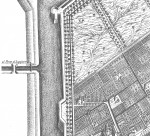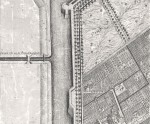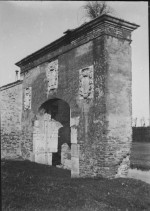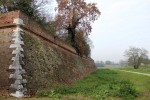Porta Catena and salient
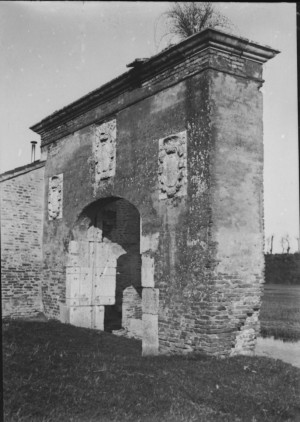
L'antica Porta Catena nel 1926, foto di Walter Segantini (Archivio Segantini©,su gentile concessione di Giuseppe Tassinari)
Built in the early seventeenth century, the city gate known as Porta Catena was located at the mouth of the navigable canal that connected the River Po at Pontelagoscuro the moat of Castello Estense. However, it was obliterated by bombs during WWII.
Historical notes
To the south of the Torrione del Barco, the curtain wall was rebuilt at various points immediately after the Second World War. Up to the point at which Corso Porta Po and Viale Cavour meet (which, during the Este era, was occupied by the Porta di San Benedetto), the only structure of note is a trapezoidal salient (not very prominent, it cannot be counted as a true bastion). To the north of this, in 1938, two archways were built based on a design by an architect named Di Fausto, allowing residents of the new quarter around Via Arianuova to reach the industrial zone near Barco and Pontelagoscuro. Known as Porta Catena, due to the proximity to an entry building of the same name that was entirely razed to the ground by the bombings of 1944, the two passageways were rebuilt in 1958.
The original Porta Catena (which dates back to the early seventeenth century) did not open onto the walls, in that it was a river port located at the mouth of the navigable canal that connected the Po at Pontelagoscuro to the Castello Estense (Este Castle) trench: the name can be attributed to the use of the chains (catene) which were used to prevent boats from passing through at night, or whenever necessary. In the Casa Romei municipal lapidary, there are still a number of examples of the marble high reliefs that decorated the façades of the Porta Catena, bearing the insignia of Pope Urbano VIII Barberini, Cardinal Antonio Barberini (1631), his nephew, and Cardinal Legate Stefano Durazzo (1634-1637).
The aforementioned canal that connected Ferrara to Pontelagoscuro was referred to as Cavo del Barco until 1645, before being renamed Canale Panfilio in honour of Pope Innocent X (Giovanni Battista Pamphilj). It was dredged and enlarged in order to make the section that corresponds with modern-day Viale Cavour navigable, and it continued to be used as a canal until the early 1860s, when it was completely filled in.
Around Porta Catena
Near the two passageways, close to the walls, is the wooded area of the Capinere Garden of L.I.P.U. (the Italian Bird Protection League). It was built in 1992 on the grounds of an abandoned campsite to care for wounded animals of various species coming from the Province of Ferrara and its surroundings. It includes fourteen aviaries, a pond inhabited by mallards and flamingoes and a veterinary clinic.
A little further down the way, between Via Porta Catena and Via Gustavo Bianchi, one can see the Motovelodromo. Inaugurated in 1952, it features a 333 m indoor track and a sports pitch measuring 90 x 50 m for minor sports, and has a capacity of 2,500 seated and 5,000 standing. Later on, near the Porta Catena archway, the Palazzeto dello Sport was built for boxing, fencing, gymnastics and weightlifting. Studies were carried out on how to build the new athletic zone, with the idea of opening a sports camp featuring enough space to potentially host school practice sessions. In 1975, a local strategic plan destined 1,200 hectares to the new Urban Park, while the sports area, with the Fausto Coppi Motovelodromo was given new pitches and equipment for tennis, five-a-side football and skating (Lottici 2008).
In Viale Francesco Tumiati, close to the two archways, is the Palapalestre sports centre, which features a few murals to decorate its exterior walls, created in 2012.
Bibliography
- Ugo Malagù, Le mura di Ferrara, Ferrariae Decus-Ente Provinciale per il Turismo, Ferrara 1960
- Paolo Ravenna, Le mura di Ferrara. Immagini e storia, Panini, Modena 1985
- Luciano Maragna, La storia del Canale Panfilio e di viale Cavour di Ferrara, 1599-1887, Ferrara 2008
- Ferrara. Storia, vie e piazze entro le Mura, in Adriano Lottici (a cura di), “Quaderni UTEF” 2018
Fototeca
Related Themes
Compiling entity
- Assessorato alla Cultura e al Turismo, Comune di Ferrara

